<< Previous | Displaying results 4951-5000 of 6769 for "" | Next >>
Scene from a Romani (Gypsy) camp: Roma (Gypsies) in front of their tents. Romania, 1936–40. (Bundesarchiv inventory number 146-2001-16-20A.)
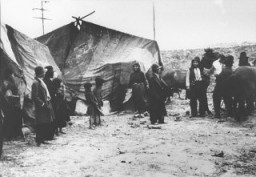
Romani (Gypsy) women boil laundry and hang it to dry in the middle of the camp at Marzahn. Germany, June 1936. Shortly before the opening of the 1936 Olympic Games in Berlin, the police ordered the arrest and forcible relocation of all Roma in Greater Berlin to Marzahn, an open field located near a cemetery and sewage dump in eastern Berlin. Police surrounded all Romani encampments and transported the inhabitants and their wagons to Marzahn.
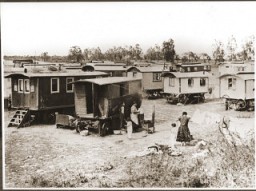
A man works outside his family's dwelling in a Roma (Gypsy) encampment in the city of Haarlem. The Netherlands, October–November 1940.
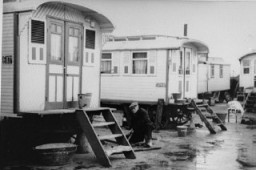
Romani (Gypsy) women march to work in the Lackenbach internment camp. Lackenbach, Austria, 1940-1941.
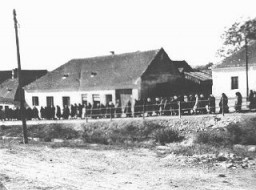
A group of Romani (Gypsy) prisoners in Belzec labor camp, 1940. The Belzec labor camp and its subsidiaries were dismantled at the end of 1940.
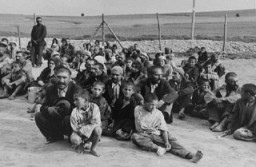
German police guard a group of Roma (Gypsies) who have been rounded up for deportation to Poland. Germany, 1940–45.
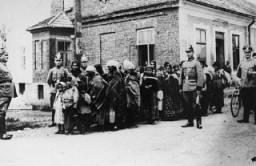
Romani (Gypsy) children play outside at the Jargeau internment camp. The camp was established in response to a German order in October 1940 calling for the arrest and confinement in camps of all Frenchmen or foreigners in the Loiret region who did not have a permanent residence. Jargeau, France, 1941–45. Conditions in the camp were extremely poor and the lack of sanitation facilities led to the periodic outbreak of epidemics.
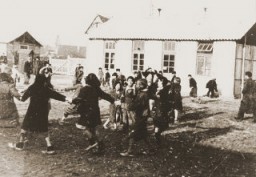
Roma (Gypsies) remove bodies from the Iasi-Calarasi death train during its stop in Tirgu-Frumos. Two trains left Iasi on June 30, 1941, bearing survivors of the pogrom that took place in Iasi on June 28-29. Hundreds of Jews died on the transports aboard crowded, unventilated freight cars in the heat of summer. Romania, July 1, 1941.
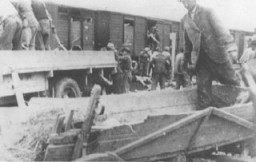
A Serbian gendarme serving the Serbian puppet government led by Milan Nedić escorts a group of Roma (Gypsies) to their execution. Yugoslavia, ca. 1941–1943.
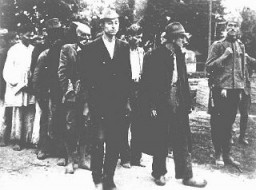
View of the entrance to the "Gypsy camp" on Brzezinska Street in the Lodz ghetto in occupied Poland. Photograph taken in 1942.
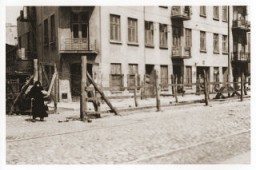
German naval officer Martin Niemöller (top, foreground) commands a U-Boat during World War I. Flensburg, Germany , ca. 1914–17.

Pastor Martin Niemöller at his desk in his home. Berlin, Germany, ca. 1936.
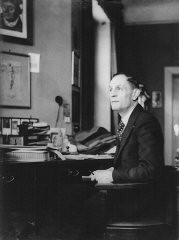
Quotation from Martin Niemöller on display in the Permanent Exhibition of the United States Holocaust Memorial Museum. Niemöller was a Lutheran minister and early Nazi supporter who was later imprisoned in the camp system for opposing Hitler's regime. First they came for the Socialists, and I did not speak out-Because I was not a Socialist.Then they came for the Trade Unionists, and I did not speak out-Because I was not a Trade Unionist.Then they came for the Jews, and I did not speak out-Because I was…
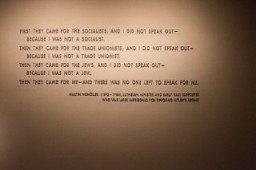
A visitor stands in front of the quotation from Martin Niemöller that is on display in the Permanent Exhibition of the United States Holocaust Memorial Museum. Niemöller was a Lutheran minister and early Nazi supporter who was later imprisoned for opposing Hitler's regime.
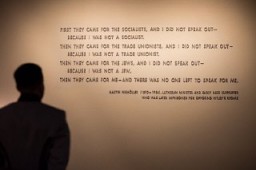
Visitors stand in front of the quotation from Martin Niemöller that is on display in the Permanent Exhibition of the United States Holocaust Memorial Museum. Niemöller was a Lutheran minister and early Nazi supporter who was later imprisoned for opposing Hitler's regime.
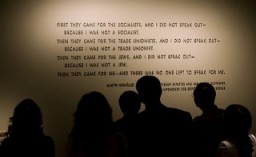
SS General Reinhard Heydrich in his office during his tenure as Bavarian police chief. Munich, Germany, April 11, 1934.
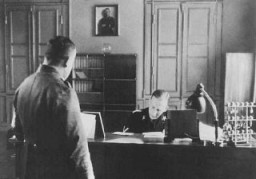
Reinhard Heydrich (right) and his deputy, Karl Hermann Frank (center), stand at attention during Heydrich's inauguration as governor of the Protectorate of Bohemia and Moravia. Prague, September 1941.
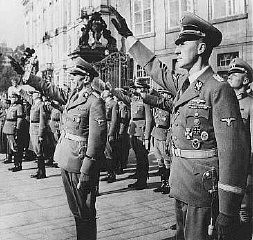
The damaged car of SS General Reinhard Heydrich after an attack by Czech agents working for the British. Prague, Czechoslovakia, May 27, 1942.
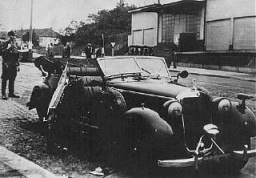
SS chief Heinrich Himmler (right) during a visit to the Auschwitz camp. Poland, July 18, 1942.
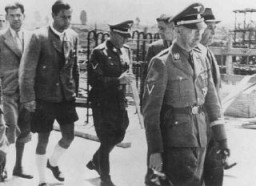
SS chief Heinrich Himmler (front row, left) and Mauthausen commandant Franz Ziereis (second from left) inspect inspect the Wiener Graben quarry during an official tour of the Mauthausen concentration camp. Austria, April 27, 1941.
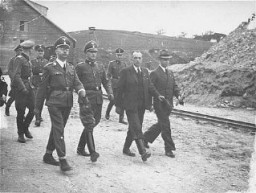
SS chief Heinrich Himmler reviews a unit of SS-police in Krakow, Poland, March 13, 1942.
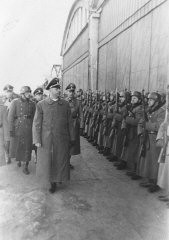
SS chief Heinrich Himmler addresses a group of soldiers in a cavalry regiment of the Waffen SS in the eastern territories. 1942.
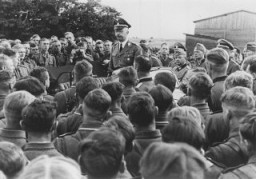
Heinrich Himmler, head of the SS, speaks to an inmate of the Dachau concentration camp during an official inspection. Dachau, Germany, May 8, 1936.
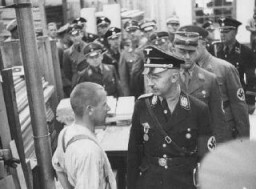
A collection of valises belonging to Jews who were deported to killing centers. These valises are displayed at the base of the railcar on the third floor of the Permanent Exhibition at the United States Holocaust Memorial Museum. Washington, DC, 1993–1995.
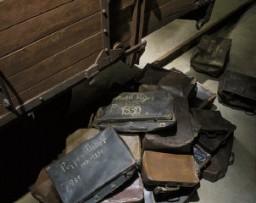
View of the photo mural of a selection at Auschwitz-Birkenau taken through the open railcar on the third floor of the Permanent Exhibition at the United States Holocaust Memorial Museum. Washington, DC, 1993–95.
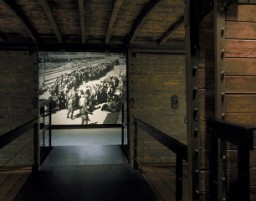
A pedestrian reads a notice announcing an upcoming public meeting, scheduled for Tuesday, December 3, to urge Americans to boycott the upcoming 1936 Berlin Olympics. New York, United States, 1935.
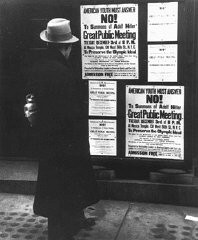
Athletes Jesse Owens of the United States (right) and Lutz Long of Germany at the Olympic stadium. Berlin, Germany, 1936.
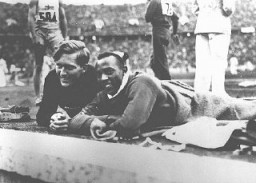
Members of the US Olympic team—runners Helen Stephens and Jesse Owens—at the Berlin Olympic Games. Germany, August 1936.
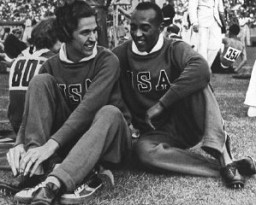
During the 1936 Olympics in Berlin, US runner Jesse Owens begins the 200-meter race in which he established a new Olympic record of 20.7 seconds. Berlin, Germany, August 2, 1936.
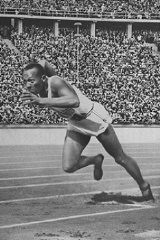
Repairs and improvements are made to the courtroom where the International Military Tribunal trial of war criminals would be held. The holes in the walls at the top (when completed) housed radio commentators and public address operators. September 11, 1945.
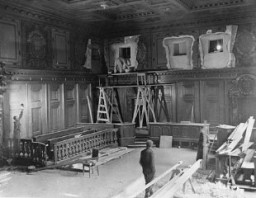
The courtroom in the Palace of Justice, chosen as the location for the International Military Tribunal trial of war criminals. This photograph shows the courtroom before any repairs or alterations were made. Nuremberg, Germany, August-September 1945.
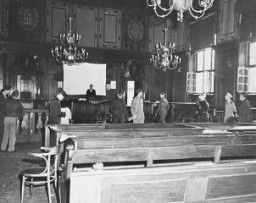
View during the remodeling of the Palace of Justice in Nuremberg in preparation for the International Military Tribunal. Nuremberg, Germany, 1945.
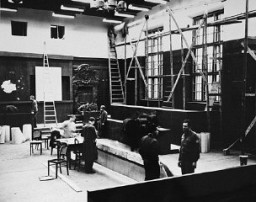
View of the interpreters' section in the courtroom during the International Military Tribunal. Nuremberg, Germany, March 29, 1946. The Nuremberg trials were an early experiment in simultaneous translation. The charter of the International Military Tribunal stated that the defendants had the right to a fair trial and that, accordingly, all proceedings be translated into a language that the defendants understood.
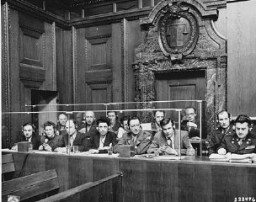
View of the Palace of Justice (left), where the International Military Tribunal trial was held. Nuremberg, Germany, November 17, 1945. The Palace of Justice was selected by the Allied powers as the location for the International Military Tribunal (IMT) because it was the only undamaged facility extensive enough to accommodate a major trial. The site contained 20 courtrooms and a prison capable of holding 1,200 prisoners.
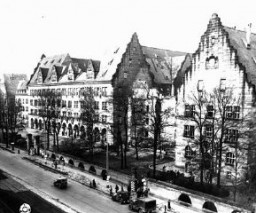
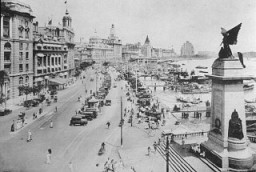
German Jewish refugee Erwin Eisfelder stands outside Cafe Louis on Ward Road. The cafe was named in honor of his father. It was a popular gathering place for refugees in Shanghai during the war years. Shanghai, China, ca. 1944.
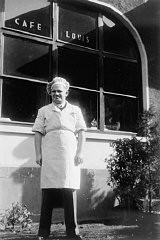
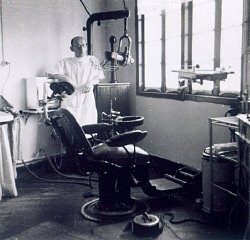
German Jewish refugee artist David Bloch. In November 1938 Bloch was interned for several weeks in the Dachau concentration camp near Munich. With the help of his brother in the United States, he escaped from Germany to Shanghai in May 1940.

Two German Jewish refugee women stand behind the counter of the Elite Provision Store (delicatessen) in Shanghai. Pictured on the left is the owner, Gerda Harpuder; on the right is her cousin Kate Benjamin. In 1939 Hans and Gerda Harpuder sold their crystal, silver, and other family possessions shipped from Berlin in order to open a grocery store in Hongkew at 737 East Broadway.

Photograph of Jan Zwartendijk with his daughter Edith and son Jan, Jr., Kovno, 1939-1940. Zwartendijk aided Jewish refugees by issuing permits for them to enter Curaçao, a Dutch colonial possession in the West Indies.

Yitzhak Gitterman (left), Joint Distribution Committee (JDC) director in Warsaw, meets with the representative of an Orthodox Jewish organization. Warsaw, Poland, date uncertain.
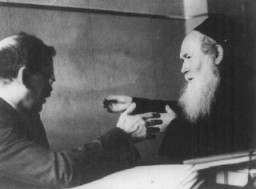
American military police admit a father and daughter, both displaced persons, to the refugee shelter at Fort Ontario. Oswego, New York, United States, after August 4, 1944.
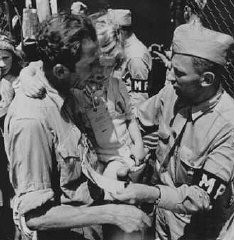
Jewish refugees from Europe arrive at the emergency refugee shelter at Fort Ontario, in the United States. A father, holding his daughter, checks his tags. Oswego, New York, United States, August 4, 1944.
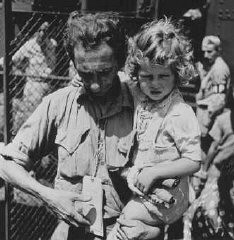
Portrait of John Pehle, Executive Director of the War Refugee Board. United States, 1940s.
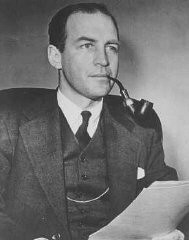
Meeting of the War Refugee Board in the office of Executive Director John Pehle. Pictured left to right are Albert Abrahamson, Assistant Secretary of the Treasury Josiah Dubois, and Pehle. Washington, DC, United States, March 21, 1944.
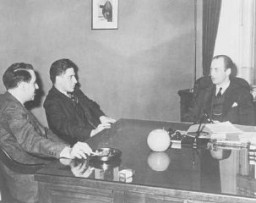
Photo taken in Secretary of State Cordell Hull's office on the occasion of the third meeting of the War Refugee Board. Hull is at the left, Secretary of the Treasury Henry Morgenthau, Jr., is in the center, and Secretary of War Henry L. Stimson is at the right. Washington, DC, United States, March 21, 1944.
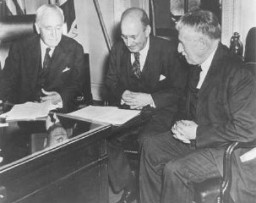
An aerial view of the Nuremberg prison, where defendants in the International Military Tribunal war crimes trial were held. Photograph taken in Nuremberg, Germany, between October 1945 and October 1946.
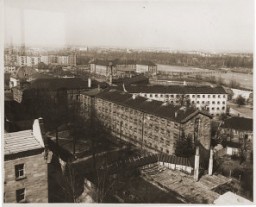
At the time of the International Military Tribunal, the city of Nuremberg reflected the devastation of war, as did much of Europe. This landscape of destruction stands in stark contrast to the Nazi rallies held in Nuremberg only years earlier.
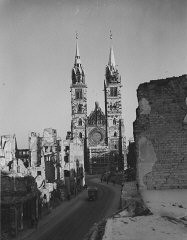
View of the bombed-out city of Nuremberg. Visible in the distance is the twin-spired Lorenz Church, and on the right, a statue of Kaiser Wilhelm I. Nuremberg, Germany, 1945.
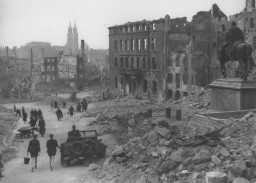
The inhabitants of Nuremberg watch a parade of US troops through their city. Nuremberg, Germany, 1946.
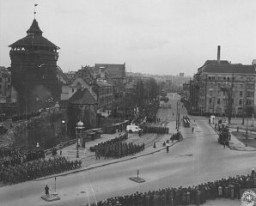
We would like to thank Crown Family Philanthropies, Abe and Ida Cooper Foundation, the Claims Conference, EVZ, and BMF for supporting the ongoing work to create content and resources for the Holocaust Encyclopedia. View the list of donor acknowledgement.